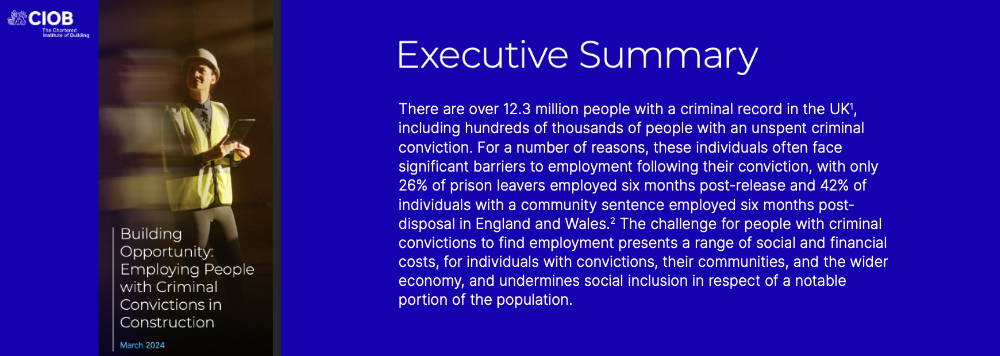Employing People with Criminal Convictions in Construction
This report looks into the barriers and opportunities to recruit people with a criminal conviction into the sector.
Negative stigma and a lack of proper training opportunities are blocking many people with criminal records from earning a second chance at life within the construction industry, a Chartered Institute of Building (CIOB) report has revealed.
The report, Building Opportunity: Employing People with Criminal Convictions in Construction, shows individuals with a criminal record often face significant barriers to gaining employment within the industry including perceived risk to the business by employers and fears about business reputation. However, the report also shows that many construction businesses are taking proactive steps to make recruitment more accessible for people with criminal convictions.
It urges the Government to break down barriers and provide more accessible training opportunities to improve individual’s employability and ease the skills shortage in the construction industry.
Statistics show nearly 70 per cent of people leaving prison* are still without work six months after their release. CIOB says breaking down barriers could lower unemployment amongst people with criminal convictions and increase construction companies' social value impact.
A copy of the full report can be accessed via this link Employing People with Criminal Convictions in Construction report
Please note following a request from the New Futures Network (NFN), this statistic has been changed from nearly 75 per cent to nearly 70 per cent.
This article appears on the CION news and blog site as "Employing People with Criminal Convictions in Construction" dated March 12, 2024 and was written by Niamh Evans
[edit] Related articles on Designing Buildings
- Apprenticeships for prisoners.
- Building back better with apprenticeships.
- CIOB aims to help ex-offenders build a career in construction.
- Construction apprenticeships.
- Ex-offender Community.
- Industry work placement.
- Projects deliver meaningful change at young offenders institution.
- Non-residential institution.
- Residential institution.
- Secure residential institution.
- Tackling the construction skills shortage.
Featured articles and news
RTPI leader to become new CIOB Chief Executive Officer
Dr Victoria Hills MRTPI, FICE to take over after Caroline Gumble’s departure.
Social and affordable housing, a long term plan for delivery
The “Delivering a Decade of Renewal for Social and Affordable Housing” strategy sets out future path.
A change to adoptive architecture
Effects of global weather warming on architectural detailing, material choice and human interaction.
The proposed publicly owned and backed subsidiary of Homes England, to facilitate new homes.
How big is the problem and what can we do to mitigate the effects?
Overheating guidance and tools for building designers
A number of cool guides to help with the heat.
The UK's Modern Industrial Strategy: A 10 year plan
Previous consultation criticism, current key elements and general support with some persisting reservations.
Building Safety Regulator reforms
New roles, new staff and a new fast track service pave the way for a single construction regulator.
Architectural Technologist CPDs and Communications
CIAT CPD… and how you can do it!
Cooling centres and cool spaces
Managing extreme heat in cities by directing the public to places for heat stress relief and water sources.
Winter gardens: A brief history and warm variations
Extending the season with glass in different forms and terms.
Restoring Great Yarmouth's Winter Gardens
Transforming one of the least sustainable constructions imaginable.
Construction Skills Mission Board launch sector drive
Newly formed government and industry collaboration set strategy for recruiting an additional 100,000 construction workers a year.
New Architects Code comes into effect in September 2025
ARB Architects Code of Conduct and Practice available with ongoing consultation regarding guidance.
Welsh Skills Body (Medr) launches ambitious plan
The new skills body brings together funding and regulation of tertiary education and research for the devolved nation.
Paul Gandy FCIOB announced as next CIOB President
Former Tilbury Douglas CEO takes helm.
UK Infrastructure: A 10 Year Strategy. In brief with reactions
With the National Infrastructure and Service Transformation Authority (NISTA).
























